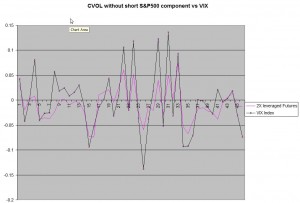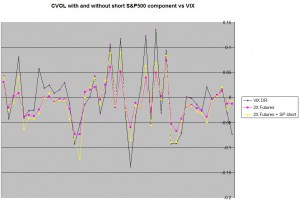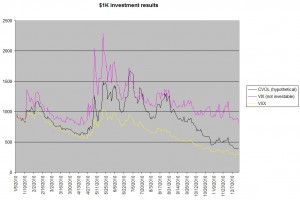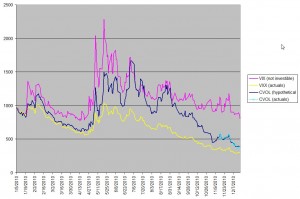Update: Citigroup has halted new share creations on CVOL. It should be avoided.
This baby is built for speed—not distance.
Fortified with several cups of coffee I took on the tough stuff in Citigroup’s CVOL pricing supplement. The other volatility ETNs (e.g., VXX, VXZ) limit themselves to various combinations of volatility futures—CVOL adds a variable leveraged short S&P 500 position. I’ve been wondering why this component was included—I was hoping that it was intended to reduce the negative “roll yields” that have plagued most volatility ETNs. However my analysis indicates the S&P500 short position is designed to improve CVOL’s match to the day-to-day moves of the VIX cash index. A noble goal, but not the one I wanted.
Just using leveraged (2X) 3 and 4-month volatility contracts CVOL would have achieved about a 0.83 statistical correlation with the day-to-day moves of the VIX index in 2010. Adding the short S&P500 factor boosts that up to 0.86 (anything above 0.7 is considered to be highly correlated). Unfortunately, at least in 2010, this short position would have resulted in a faster decay than a pure daily roll from 3 to 4 month volatility contracts. Over 2010 I project CVOL would have lost about 61% of its value, which compares to the year-to-date VIX index dropping 20% and VXX losing 71%. It isn’t surprising that a short S&P500 position in a rising market hurts.
The modeling
To make this analysis more manageable, and to get around the fact that I don’t have historic data on many of the moving parts of CVOL, I made some simplifying assumptions. The graph at the end of this post suggests these assumptions didn’t materially change the results. My simplifications:
- I ignored the interest earned putting unused cash in 90 day treasury bills (current yields would produce about 0.4% per year)
- The short S&P 500 component used in CVOL includes the cost of dividends that a short position would incur—I ignored the dividend part (currently running around 2% per year).
- I ignored the 1.15% per year investor fee (which is assessed daily at 1.15%/365)
- Lacking data for the rolling position in 3rd and 4th month volatility futures, I used Barclay’s VXZ ETN—which rolls 4,5,6,7 month contracts. VXZ probably has less volatility and lower yield roll, but I suspect the differences are relatively minor.
.
If you don’t use its S&P500 factor, CVOL’s daily returns compared with the VIX index would look like this for mid October through December 17th:

.
.
.
.
.
.
.
.
.
Not Bad. But if you add their S&P500 short component (weighting is updated monthly), it looks better still:

.
.
.
.
.
.
.
.
..
.
If you could have invested $1K in the VIX index, VXX, and CVOL, at the beginning of 2010 your results would looked something like this:

.
.
.
.
.
.
.
.
.
.
CVOL appears to perform much better than VXX in matching the index, but still suffers considerably from yield roll. The final graph below adds the actual CVOL prices from its introduction till December 17th. I adjusted the investment values of the actual vs. hypothetical CVOLs to match at the November 15th introduction.

.
.
.
.
.
.
.
.
.
.
The path match between CVOL’s actual vs hypothetical values appears to validate that my calculations are fundamentally correct and that my simplifications don’t overly skew the results. If you are interested downloading the spreadsheet I used for these calculations and these charts visit this post.
.

Have you ever seen a fund that offers access to variance swaps which should give you the volatility risk premium that you have to pay by going long futures on the vix? I have just read about the theory at this link:
http://www.finanzafirenze.org/IRMC/files/Volatility%20as%20an%20asset%20class%20for%20long%20term%20investors_Ombretta%20Signori.pdf
but not seen how it might work in practice (or how it would have paned out in 2008 after this study was written….
Hi Benjamin,
I’m pretty sure there are no USA based ETFs or ETNs that are tied to variance swaps. It looks like OTC swaps and the CBOE variance futures are ways to do this.
With the existence of the futures it seems like someone could do an ETN for this–similar to VXX. It would probably suffer from contango driven erosion I suspect.
— Vance